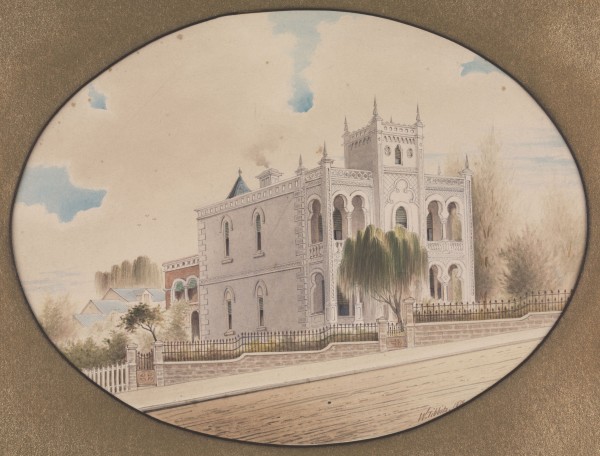Salad Days
In the Victorian era when architectural style leaned heavily towards the Italianate one East Melbourne house stood out. It was beautifully depicted by artist, William Tibbits, in 1879. Burnell, as it was later known, at 109 Albert Street, was built for John Speechly Gotch, founder of the well-known firm of Gordon and Gotch, newsagents and wholesale distributors of print media. Gotch bought the existing timber house on the site in 1863 and spent several years transforming it into a brick house of 12 rooms plus coach house and stables. This Moorish fantasy was completed by 1877.
The architect of this transformation has never been confirmed, but several tender notices appeared in the Argus between 1868 and 1875 under the name of Charles Webb, all calling for alterations to premises in Albert Street. The ads are too vague to be conclusive but nevertheless very tempting. Charles Webb is perhaps best known as the designer of the Windsor Hotel, but he was active in East Melbourne designing, amongst others, Yarra Park State School; Mosspennoch, 36 Clarendon Street; Tasma Terrace, 2-12 Parliament Place and Burlington Terrace on the corner of Albert and Lansdowne Streets.
It seems the house was built with entertaining in mind and perhaps this accounts for its fairy-tale appearance. There was always a reason for an entertainment of one kind or another. Mrs Gotch was one of the founders of the East Melbourne Congregational Church (now the Antiochian Orthodox Church of St Nicholas on the corner of Victoria Parade and Simpson Street) and was also an active committee member and, for a time, president of many charitable organisations such as the Austin Hospital, Collingwood Creche, the Society for the Prevention of Cruelty to Children and the Ministering Children’s League. They were all helped by the money that could be raised from garden parties and fetes. Of course, there were the personal events too, ‘at homes’ and at least one wedding.
We know from newspaper accounts of such events that there was a drawing room, a dining room, a library and a music room. When the Gotch family was entertaining all were decorated with brightly coloured annuals such as poppies or nasturtiums and an abundance of grasses. The music room had a parquet floor and an organ. On the occasion of their daughter’s marriage Mrs Gotch, Elizabeth, or Lizzie, played the organ for the enjoyment of the guests. For large events tables and chairs would be brought out on to the extensive lawn on the eastern side of the house. Musical entertainments, meanwhile, would continue in the music room.
Parties remained a big part of the family’s life even generations later. A grand-daughter, Gertrude Courtney Dix, made a name for herself in 1920 as the favourite dance partner of the Prince of Wales, later King Edward VIII, during his visit to Australia.
After the deaths of John and Elizabeth Gotch, in 1901 and 1914 respectively, the house was inherited by their son, Edward. In the post-war years lack of available staff meant big houses were less sought after and when the house was sold in 1920 it was advertised as self-contained flats and, for the first time, given the name Burnell. Soon after the garden to the east was sold and flats built.
In an era when love of or respect for our old buildings was minimal East Melbourne lost one of its greatest architectural treasures. Burnell was demolished in the late 1960s to provide vehicle access and carparking to the Freemasons’ Hospital. History and beauty have no power against hospitals and the public good. Now thankfully, in the 21st century, we have learnt our lesson and such a treasure would rightfully have some protection.
This article first appeared in the Inner City News, May 2022


